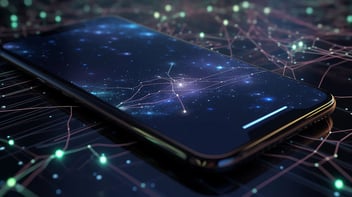Overview
- While theorized for a long time, the Internet of Things (IoT) has recently become a reality due to incredible technological advancements connected to 5G networks.
- 5G is more reliable than 4G, providing users with predictable wireless connections designed specifically for high data transmission capacity.
- While 5G is a cellular network technology offering elevated speeds, lower latency, and higher capacity than previously possible. IoT refers to the network of interconnected devices capable of communicating at higher performance levels.
- Having a service provider develop, maintain, and upgrade your 5G network brings with it profound benefits for several industries: multi-family, healthcare, commercial, manufacturing, government, education, hospitality, new construction, and public venues.
Understanding the Internet of Things (IoT)
The next evolution in interconnectivity, the Internet of Things (IoT), transforms what was once just a mobile telephone network into a system of connections built specifically to link physical devices with data exchange rates lightyears ahead of its predecessors.
Enjoying low-cost computing capabilities, the cloud, mobile technologies, and big data, IoT enables physical objects embedded with sensors, software, and other tech to collect and share data instantaneously with each other—with minimal human intervention.
While 4G has dramatically improved data transmission for mobile devices, its major shortcoming stems from the fact it wasn’t built to accommodate so many physical devices in a single environment, such as a business, hospital, or multi-family home.
With 4G, each device would require its own identification, which overburdens networks with a large number of simultaneous connections.
That’s not the case with 5G, which is designed specifically to boost IoT’s functionality.
You’ll encounter IoT examples in smart home devices and appliances (lights, thermostats, refrigerators), wearables (smartwatches, fitness trackers, eyewear), industrial machinery (robots and drones), vehicles (self-driving cars), smart city devices (traffic lights, parking meters, waste bins) and others designed to automate and optimize task performance.
So while IoT has been theorized for quite some time, several recent technological advancements connected to 5G have made its rapid interconnectivity possible:
- Advanced cloud computing. The expansion of cloud platforms makes scalability more manageable.
- Inexpensive sensor technology. More affordable and dependable sensors means more manufacturers can integrate IoT technology into their products.
- Developments in artificial intelligence. Natural language processing and generative artificial intelligence make IoT devices more attractive and affordable for residential and commercial use, fueling their propagation.
- Sophisticated machine learning and analytics. These companion technologies are opening new possibilities for storing and exchanging cloud data, superpowering the speed and precision of insights in real time.
To enhance the rapid growth of IoT, 5G is becoming more ubiquitous, which will be essential for supporting the increased number of connected users and the glut of new devices proliferating throughout all aspects of society.
Maintaining a robust 5G network is becoming a must for businesses in any industry.
Going Beyond 4G to 5G
Given its superior performance in managing hundreds of devices at high speeds and low latency, 5G is the future for healthcare, commercial, government, education, hospitality, new construction, and public venues.
Any enterprise without it will be left in the dust.
Because 5G is far more reliable, it gives users highly predictable wireless connections built for the increasing flow of data traveling between our numberless devices. Inconsistent Wi-Fi service and poor cloud connectivity between devices harm your organization’s operations and even turn away otherwise interested clients and prospects.
Few things frustrate customers more than lagging technology and fickle internet or Wi-Fi connections.
Much like 4G enabled the mass adoption of phone apps and smartphones, 5G is expected to usher in an even more interconnected world, where the boundaries between physical and digital become blurred even further.
Are 5G & IoT the Same Thing?
5G and IoT run parallel with each other, but are not, indeed, the same thing. Instead, they depend intensely upon each other as society moves into a more wireless future.
While 5G is the 5th generation of cellular network technology that offers elevated speeds, lower latency, and higher capacity than previous ones, IoT refers to both the network of interconnected devices capable of communicating at greater performance because of 5G.
In other words, 5G is a type of network that supports IoT applications, while IoT is a type of application that uses 5G networks. Together, they enable an abundance of new use cases for various industries seeking to become leaders in their respective fields.
It’s also worth noting that 5G is not the only network that can support IoT applications. IoT applications can use other similar but far less robust types of networks, including Wi-Fi, Bluetooth, or LoRaWAN.
5G just happens to be the most powerful partner currently available for IoT applications.
Benefits of Building 5G Networks by Industry
Multi-Family
This new technology improves the quality of life and convenience for residents and augments property managers' operations in multi-family buildings.
Reliable cellular service sits atop the list of requirements for apartment dwellers. Be it for an emergency or to meet the demands of daily life, dependable connectivity is a must–especially with the remote work revolution and devoted gamers clamoring for higher speeds.
As a landlord or property manager, providing stable networks and speedier wireless can justify premium rents, boosting your profitability. You might even use it as an alluring lease renewal incentive.
Plus, you can use IoT sensors and cameras to monitor your building’s conditions, maintenance, and security, employing 5G to access real-time data and alerts.
Healthcare
The emergence and expansion of telemedicine means medical professionals require real-time information accessible across secure channels. 5G networks can transmit data up to 100 times faster than current 4G networks, ensuring more rapid responses in medical situations—vital when life and death are on the line.
5G is playing a major role in improving medical outcomes for patients, especially when it comes to wearables, for instance.
“Wi-Fi connectivity and 5G technology can permit patients to be observed through associated devices that continuously distribute data on key health indicators such as blood pressure and heart rate,” explains a team of medical researchers studying 5G technology in healthcare. “When compared to other connectivity solutions, [wearables and 5G] provide security, increased capacity for the number of connected devices per square kilometer, greater service reliability, and mobility over in-home connectivity solutions such as Wi-Fi.”
New Construction
New builds are expected to have the most up-to-date features, including 5G networks and Wi-Fi. However, concrete, steel, and LEED-certified glass can bog down signal strength, something that will infuriate your prospective tenants.
By installing a powerful wireless 5G network, you avoid leasing snags and reduce the number of potentially disgruntled occupants in the future.
All new constructions are required by local and state codes to maintain an Emergency Responder Radio Communication System (ERRCS). But oftentimes that isn’t enough, which is why you’ll want to consider implementing a wireless network that features public safety distributed antenna systems (DAS) with a cellular enhancement system.
This will guarantee coverage throughout your entire property.
Industrial & Manufacturing
Manufacturing and industrial settings are durable and furnished with heavy materials designed to withstand intense operational conditions and uses. However, thick concrete and metals obstruct wireless signals, undermining your operations.
High-bandwidth solutions are required to break through these barriers, ensuring team members and production remain unhindered.
Powered by 5G, IoT is often employed with autonomous vehicles, robots, and other automated systems, including asset inventory management, and maintenance. In fact, industrial sensors can even reveal when your production output is in jeopardy.
Assisted by sensor alerts, you’ll immediately be notified of inaccuracies or production slowdowns, enabling you to remove problematic equipment until it’s been repaired—saving you from unnecessary costs caused by unexpected downtimes.
Commercial
Landlines are being discarded by more and more retailers and commercial property managers, joining the heap of wires that is the corpse of late twentieth-century technology.
5G is a cost-effective way to refine worker and customer experiences while increasing property revenue, positioning your office buildings as high-value for potential renters
Secure data exchange and collection should also increase worker productivity, as well.
Public Venues
Tickets have gone almost completely mobile.
However, the entrance experience can quickly become agonizing for attendees and venue staff when mobile devices lack access to a stable 5G network. And few places accumulate more network traffic demand than large public venues, such as concerts or sporting events.
Attendees rely on cellular use throughout the event to communicate and for sharing videos and photos on social media and scrolling through various mobile apps. They want to broadcast these important moments to family, friends, and social media followers.
Unending buffering or unstable network connections will mar their otherwise wonderful experience in your venue. By investing in a high-speed cellular service, you can promise visitors easy communication and comprehensive coverage.
Hospitality
Curating personalized and engaging experiences for guests and staff is central to top-class hospitality.
With 5G and IoT devices hotels, restaurants, and entertainment venues can customize room preferences (temperature, lighting, and entertainment) and deliver other services. Ordering food, booking activities, and checking out can be at your customers’ fingertips with their smartphones or voice assistants.
5G provides high-speed and seamless connectivity for guests and staff, as well as supports immersive and interactive technologies, such as augmented and virtual reality, and live streaming. These technologies can also help you optimize reservations, check-ins, housekeeping, and security, powered by real-time data analytics and automation.
When you devote resources toward robust internet and cellular infrastructure, your guests are going to have a much more positive experience, which comes back to you in the form of reinforced brand loyalty and increased revenue.
Public safety distributed antenna systems (DAS) are also a must for hospitality, facilitating quick dispatching of first responders in emergencies.
Education
Educators, students, and teachers expect smooth communication channels, be it in higher education or at the local public school. Plus, people anticipate consistent bandwidth regardless of where they are on your campus.
Network signals similarly need to pass through oftentimes densely constructed buildings full of classrooms, residents, or dining areas. Fortunately, 5G technology amplifies your ability to do that, enhancing student productivity and the administration’s security.
Educational spaces are inundated with IoT and other electronic devices, including laptops, desktops, smartphones, and tablets, overburdening 3G and 4G networks. However, 5G’s high bandwidth is built to accommodate such elevated data transmission rates across numberless devices.
Plus, public safety personnel need to be able to tap into dependable communication systems during fires, active shooter situations, and other emergencies. Educational institutions can’t afford to encounter dropped calls or encumbered connectivity when addressing high-stakes circumstances.
Government
Cyberattacks and security breaches are a constant threat to government agencies, so they need wireless networks with complete protection when transmitting sensitive information.
Whether it’s the marble and granite used to build federal government buildings or the thick walls of brick found inside many older local government structures, 3G and 4G network signals struggle to cut through dense barriers. Even 5G can be limited at times by such thick building materials.
However, by pairing 5G with more sophisticated cellular systems, you can achieve scalable and secure interconnectivity within your building.
If you’re a public sector organization, such as a library, meeting hall, or park, extended remote coverage that ensures privacy is a necessity—and a savvy 5G service provider can make that possible.
Plus, a trustworthy network is an absolute must for your internal business operations, including people counting, queue management, concession purchases, and monitoring other public safety concerns.
Regardless of your industry, building out a 5G or IoT network can be expensive, especially up front. And there are maintenance costs for managing Wi-Fi you’ll need to account for, as well.
However, the right service provider, such as AirTower Networks, will accommodate a long-term partnership with you, which translates to far less up-front costs. We will also operate, maintain, and upgrade your system as network technologies continue to advance, delivering incredible connectivity.
AirTower offers customized solutions such as 5G cellular, managed Wi-Fi, private LTE, and more to industries ranging from healthcare and hospitality to commercial and governmental. We furnish our clients with cutting-edge solutions that provide seamless in-building connectivity, enhance their productivity, and improve their bottom line. Contact us today for a quote.
Subscribe to the Airtower Networks Blog
Get emailed articles, guides, and updates.




